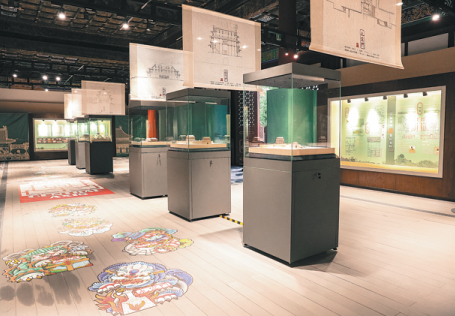Time line
Exhibition in support of the application for world heritage status for Beijing Central Axis highlights its historical and cultural significance, Wang Ru reports.
By Wang Ru | CHINA DAILY | Updated: 2020-10-22 07:28
 The exhibition shows many iconic sights in Beijing, such as the Palace Museum, the Temple of Heaven and the Imperial Ancestral Temple, that are located on or alongside the central axis. CHINA DAILY
The exhibition shows many iconic sights in Beijing, such as the Palace Museum, the Temple of Heaven and the Imperial Ancestral Temple, that are located on or alongside the central axis. CHINA DAILY
Exhibitions about Beijing's central axis have been held many times before, but usually focusing on some particular aspects related to the axis such as the historical cultural and creative products that were produced along it. This one is more complete and systematic, according to Lyu.
The exhibition has three parts, introducing the concept and history of the axis, the application for it to be identified as part of the world's cultural heritage and the future development of it.
"The axis not only reflects the lifestyle of ancient Chinese society, but also serves as a living carrier of traditional Chinese culture and value," says Zheng Chuhan, an engineer at Architectural Design and Research Institute of Tsinghua University.
In ancient China, the central axis was viewed as integrating the political idea of the "center brings power", the ethical thought of the "center creates justice", and the aesthetic tradition of "beauty and virtue are combined", reflecting the concept of the ideal capital that originated in the pre-Qin period (c.2100-221 BC), Zheng says.
Throughout Chinese history, the capitals of many dynasties had central axes, but Beijing's is the only one that remains and still plays an essential role today, according to Lyu. "For example, the central axis of Chang'an, one of the capitals of the Tang Dynasty (618-907) has long become a historical site. People in today's Luoyang city can no longer see the central axis that existed in the Sui (581-618) and Tang dynasties.
"Although the axis of Xanadu is still visible in its site in Xilingol League of northern China's Inner Mongolia autonomous region, it's just an archaeological site and is no longer in use today."
Since the axis is still in use in Beijing, it is not only about history and culture, but also about modern city life. According to Liu Yulong, deputy dean of Architectural Design and Research Institute of Tsinghua University: "We believe that protection of the axis combines historical and cultural heritage protection with modern city life, and integrates the historical and cultural connotations with those of modern life to create a better future."
Contact the writer at wangru1@chinadaily.com.cn
























